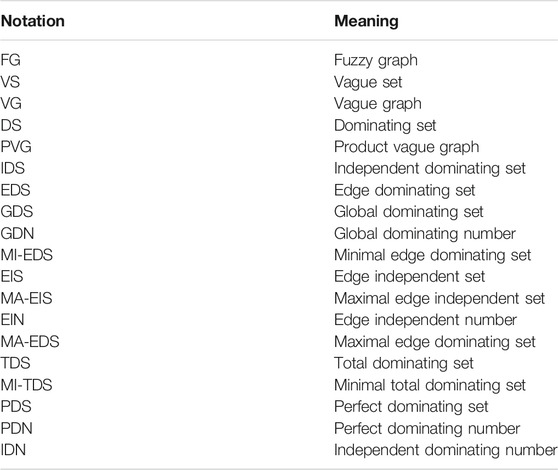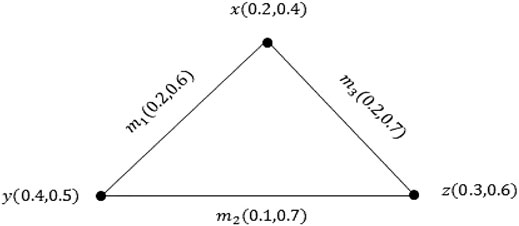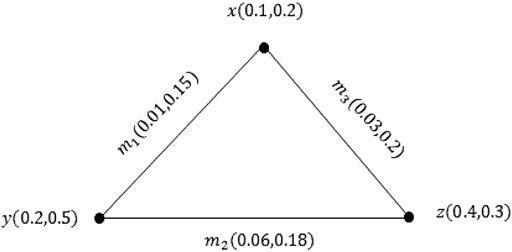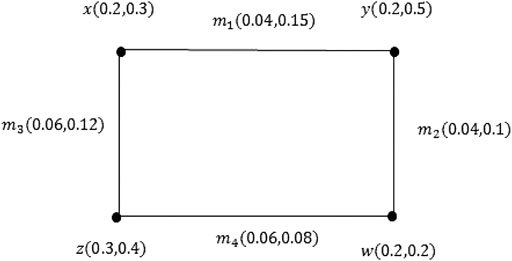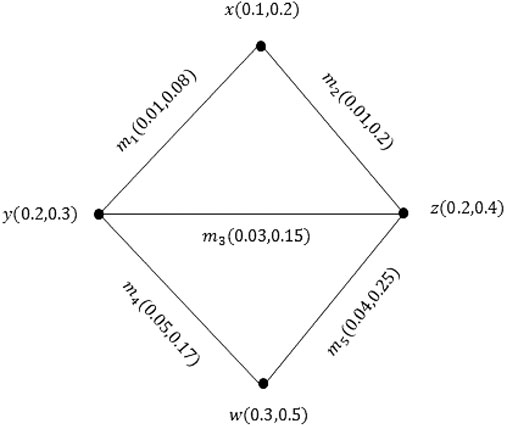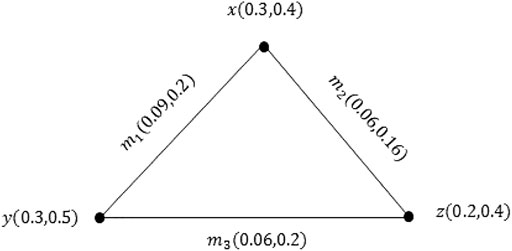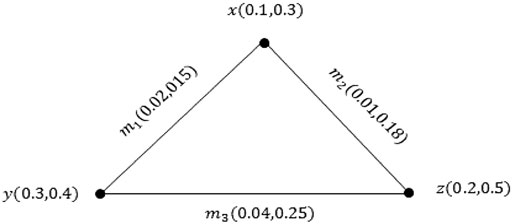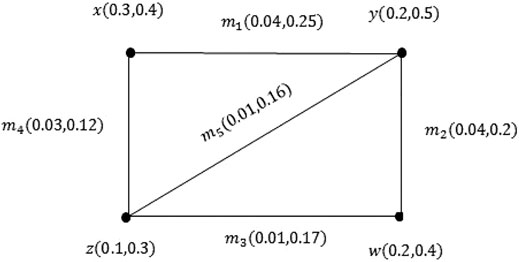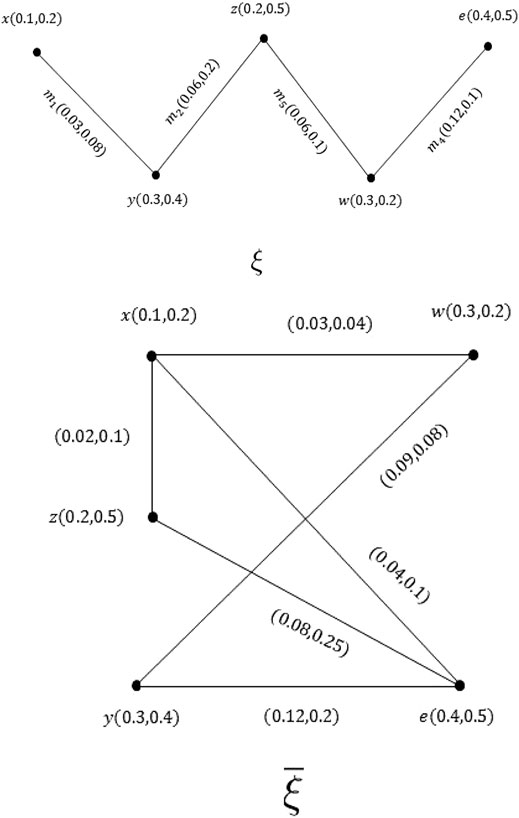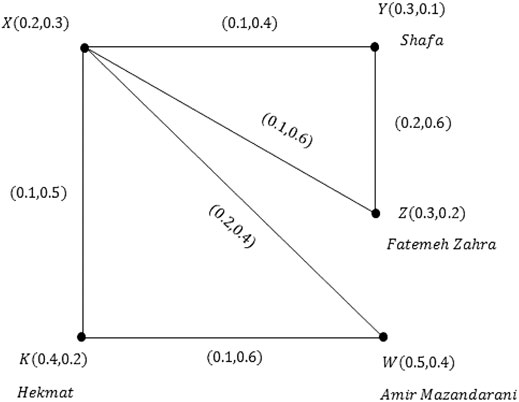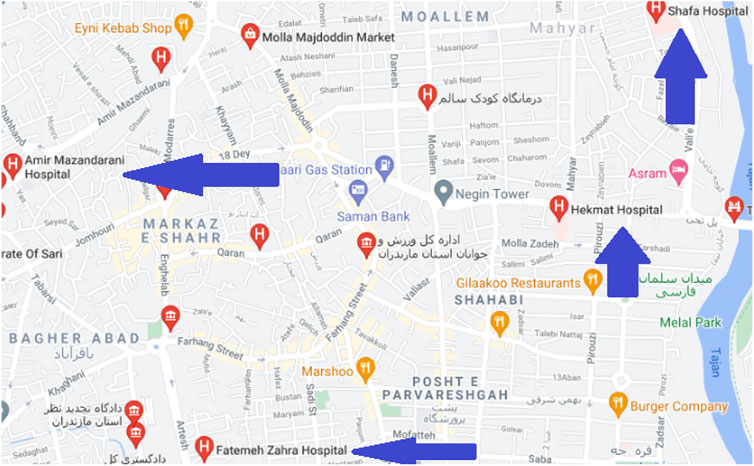Certain Properties of Domination in Product Vague Graphs With an Application in Medicine
- Institute of Computing Science and Technology, Guangzhou University, Guangzhou, China
The product vague graph (PVG) is one of the most significant issues in fuzzy graph theory, which has many applications in the medical sciences today. The PVG can manage the uncertainty, connected to the unpredictable and unspecified data of all real-world problems, in which fuzzy graphs (FGs) will not conceivably ensue into generating adequate results. The limitations of previous definitions in FGs have led us to present new definitions in PVGs. Domination is one of the highly remarkable areas in fuzzy graph theory that have many applications in medical and computer sciences. Therefore, in this study, we introduce distinctive concepts and properties related to domination in product vague graphs such as the edge dominating set, total dominating set, perfect dominating set, global dominating set, and edge independent set, with some examples. Finally, we propose an implementation of the concept of a dominating set in medicine that is related to the COVID-19 pandemic.
Mathematics Subject Classification: 05C99, 03E72
1 Introduction
Graph theory began its adventure from the well-known “Konigsberg bridge problem.” This problem is frequently believed to have been the beginning of graph theory. In 1739, Euler finally elucidated this problem using graphs. Even though graph theory is an extraordinarily old concept, its growing utilization in operations research, chemistry, genetics, electrical engineering, geography, and so forth has reserved its freshness. In graph theory, it is highly considered that the nodes, edges, weights, and so on are definite. To be exact, there may be no question concerning the existence of these objects. However, the real world sits on a plethora of uncertainties, indicating that in some situations, it is believed that the nodes, edges, and weights may be additional or may not be certain. For instance, the vehicle travel time or vehicle capacity on a road network may not be exactly identified or known. To embody such graphs, Rosenfeld [1] brought up the idea of the “fuzzy graph” in 1975. FG-models are advantageous mathematical tools for handling different domains of combinatorial problems embracing algebra, topology, optimization, computer science, social sciences, and physics (e.g., vulnerability of networks: fractional percolation on random graphs). The VS theory was defined by Gau and Buehrer [2]. Using Zadeh’s fuzzy relation [3], Kauffman [4] illustrated FGs. Mordeson et al. [5–7] evaluated some results in FGs. Pal et al. [8–10] investigated some remarks on bipolar fuzzy graphs and competition graphs. Akram et al. [11, 12] epitomized new definitions in FGs. Ramakrishna [13] described the VG concepts and examined the properties. Rashmanlou et al. [14] defined PVGs and studied new concepts such as the complete-PVG, complement of a PVG, and the edge regular PVG with several examples. Shao et al. [15–20] proposed new concepts in vague graph structures and vague incidence graphs such as the maximal product, residue product, irregular vague graphs, valid degree, isolated vertex, vague incidence irredundant set, Laplacian energy, adjacency matrix, and Laplacian matrix in VGs and investigated their properties with several examples. Also, they described several applications of these concepts in the medical sciences. Borzooei et al. [21–24] analyzed several concepts of VGs. Ore [25] defined “domination” for undirected graphs and studied its properties. Somasundaram [26] defined the DS and IDS in FGs. Nagoorgani et al. [27, 28] represented the fuzzy DS and IDS notions using strong arcs. Parvathi and Thamizhendhi [29] represented the domination number, independent set, independent domination number, and total domination number in intuitionistic fuzzy graphs [29]. Cockayne [30] and Hedetniemi [31, 32] introduced fundamentals of domination in graphs.
Fuzzy graph theory has a wide range of applications in various fields. Since indeterminate information is an essential real-life problem, mostly uncertain, modeling those problems based on fuzzy graphs (FGs) is highly demanding for an expert. A PVG is an indiscriminately comprehensive structure of an FG that offers higher precision, adaptability, and compatibility to a system when coordinated with systems running on FGs. PVGs are a very useful tool for examining many issues such as networking, social systems, geometry, biology, clustering, medical science, and traffic plans. Domination is one of the most important issues in graph theory and has found numerous applications in formulating and solving many problems in several domains of science and technology exemplified by computer networks, artificial intelligence, combinatorial analyses, etc. Domination of PVGs is an interesting and powerful concept and can play an important role in applications. Thus, in this study, we introduce different kinds of domination in PVGs, such as the EDS, TDS, PDS, GDS, and EIS, with some examples and also discuss the properties of each of them. Today, almost every country in the world is inflicted by a dangerous disease called Covid-19. Unfortunately, many people have lost their lives due to contracting this dangerous virus and the lack of necessary medical equipment for treatment. So, we have tried to identify a suitable hospital for a person infected with the coronavirus that has more appropriate medical facilities and equipment and is in the most favorable conditions in terms of distance and amount of traffic, so that time and money are saved, with the help of the DS in the VG. Some basic notations introduced in Table 1
2 Preliminaries
A (crisp) graph
Definition 2.1: [2] A VS A is a pair
Definition 2.2: [13] A pair
Example 2.3: Consider a VG ξ asFigure 1, so that
Definition 2.4: [23] Let
(1)
(2)
(3)
Definition 2.5: [24] Consider
Definition 2.6: [22] An edge
Definition 2.7: [23] A VG
Definition 2.8: [22] Consider ξ as a VG. Assuming
Definition 2.9: [14] Let
Example 2.10: Consider the PVG ξ asFigure 2.For the
In the same way, we can show that both conditions of Definition 2.9 are true for other edges. So, ξ is a PVG.
Definition 2.11: [14] An edge
Definition 2.12: [14] If ξ is a PVG, then the vertex cardinality of
Definition 2.13: [14] Let
Definition 2.14: [14] Two edges
Definition 2.15: [22] Let ξ be a PVG.
A DS K of a PVG ξ is said to be a minimal-DS if no proper subset of K is a DS.
Definition 2.16: [5] Let
Definition 2.17: [22] Two vertices,
3 New Kinds of Domination in Product Vague Graphs
Definition 3.1: Let
Definition 3.2:
Definition 3.3: An EDS D of a PVG ξ is named an MI-EDS if no proper subset of D is an EDS.
Definition 3.4: Minimum cardinality between all MI-EDSs is named an EDN of ξ and is denoted by
Definition 3.5: The strong neighborhood of an edge
Example 3.6: Consider a PVG
Definition 3.7: Let
Definition 3.8: Let
Definition 3.9: An EIS S of a PVG ξ is called an MA-EIS if for every edge
Example 3.10: Consider the example of a PVG
Definition 3.11: If all the edges are effective edges in a PVG ξ, then it is called an effective-PVG.
Definition 3.12: Assume that
Example 3.13: Consider the PVG ξ as shown inFigure 5. Obviously, ξ is an effective-PVG.
Theorem 3.14: Node cover of an EDS of a PVG ξ is a DS of ξ.
Proof: Let ξ be a PVG. Suppose that S is a node cover of an EDS K. We prove that S is a DS. Let
Definition 3.15: An edge in a PVG ξ is called an isolated edge if it is not a neighbor to any effective edge in ξ.
Example 3.16: Consider the PVG ξ as shown inFigure 6. It is obvious that
Theorem 3.17: Let ξ be a PVG without isolated edges, and there exists no edge
Proof: Let S be an MI-EDS of a PVG ξ. Suppose that
Theorem 3.18: An EIS of a PVG ξ having only effective edges is an MA-EIS if and only if it is edge independent and an EDS.
Proof: Suppose that S is an EIS of a PVG ξ having only effective edges. Consider that S is an MA-EIS of ξ. Then,
Theorem 3.19: Node cover of an MA-EIS of a PVG ξ having only effective edges is a DS of ξ.
Proof: Let S be an MA-EIS of a PVG ξ having only effective edges. Let
Definition 3.20: Consider
Definition 3.21: A TDS S of a PVG ξ is called an MI-TDS if no proper subset of S is a TDS. The minimum cardinality of an MI-TDS is named a lower-TDN of ξ and is shown by
Example 3.22: InFigure 7,
Theorem 3.23: Let
Proof: Let S be a minimal-DS and
Definition 3.24: A DS S in a PVG ξ is called a PDS if for each node
Definition 3.25: A PDS S in a PVG ξ is said to be an MI-PDS if for every
Example 3.26: InFigure 8,
Theorem 3.27: Every DS in a complete PVG ξ is a PDS.
Proof: Let S be a minimal-DS of a PVG ξ. Since ξ is complete, every edge in ξ is an effective edge and every node
Theorem 3.28: A PDS S in a PVG ξ is an MI-PDS if and only if for each node
(i)
(ii)
Proof: Let S be an MI-PDS and
Theorem 3.29: Let
Proof: Let S be an MI-PDS of ξ, and
Definition 3.30: A DS S of a PVG ξ is named a GDS if S is a DS of
Example 3.31: Let ξ and
Theorem 3.32: A DS S in a PVG ξ is called a GDS if and only if
Proof: Suppose that S is a GDS in a PVG ξ. Let x in S be dominated by y in
4 Application of Domination in Medical Sciences
Today, almost every country in the world is affected by a dangerous disease called COVID-19, which is also commonly referred to as Corona. COVID-19 is an infectious disease caused by the coronavirus of acute respiratory syndrome. Its common symptoms are fever, cough, shortness of breath, and, most recently, infertility. Although the majority of cases of the disease cause mild symptoms, some cases progress to pneumonia and multiple sclerosis. The mortality rate is appraised at 2
The vertex
After calculating the cardinality of
Clearly,
5 Conclusion
Product vague graphs are used in many sciences today, including computers, artificial intelligence, fuzzy social networks, physics, chemistry, and biology. Since all the data in the problem can be considered on it, researchers use it to display the theories in their research work well. Domination is one of the most important issues in graph theory and has found many uses and functions in terms of formulating and solving many problems in different domains of technology and science exemplified by computer networks, artificial intelligence, combinatorial analyses, etc. Domination helps consider the best way to save time and money. Hence, in this study, we introduced different concepts and properties related to domination in product vague graphs, such as the edge dominating set, total dominating set, perfect dominating set, global dominating set, and edge independent set, and studied their properties by giving some examples. Finally, an application of domination in the field of medical sciences that is related to COVID-19 has been introduced. In our future work, we will introduce vague incidence graphs and study the concepts of the connected perfect dominating set, regular perfect dominating set, inverse perfect dominating set, and independent perfect dominating set on the vague incidence graph.
Data Availability Statement
The raw data supporting the conclusion of this article will be made available by the authors, without undue reservation.
Author Contributions
All authors listed have made a substantial, direct, and intellectual contribution to the work and approved it for publication.
Funding
This work was supported by the National Key R&D Program of China (No. 2019YFA0706402) and the National Natural Science Foundation of China under Grant 61772376 and 62072129.
Conflict of Interest
The authors declare that the research was conducted in the absence of any commercial or financial relationships that could be construed as a potential conflict of interest.
Publisher’s Note
All claims expressed in this article are solely those of the authors and do not necessarily represent those of their affiliated organizations, or those of the publisher, the editors and the reviewers. Any product that may be evaluated in this article, or claim that may be made by its manufacturer, is not guaranteed or endorsed by the publisher.
References
1. Rosenfeld A. FUZZY GRAPHS††The Support of the Office of Computing Activities, National Science Foundation, under Grant GJ-32258X, Is Gratefully Acknowledged, as Is the Help of Shelly Rowe in Preparing This Paper. In: LA Zadeh, KS Fu, and M Shimura, editors. Fuzzy Sets and Their Applications. New York, NY, USA: Academic Press (1975). p. 77–95. doi:10.1016/b978-0-12-775260-0.50008-6
2. Gau W-L, Buehrer DJ. Vague Sets. IEEE Trans Syst Man Cybern (1993) 23:610–4. doi:10.1109/21.229476
3. Zadeh LA. The Concept of a Linguistic Variable and its Application to Approximate Reasoning-I. Inf Sci (1975) 8:199–249. doi:10.1016/0020-0255(75)90036-5
4. Kaufmann A. Introduction a la Theorie des Sour-Ensembles Flous. Paris, France: Masson et Cie (1973).
5. Mordeson JN, Mathew S. Fuzzy End Nodes in Fuzzy Incidence Graphs. New Math Nat Comput (2017) 13(3):13–20. doi:10.1142/s1793005717500028
6. Mordeson JN, Mathew S. Human Trafficking: Source, Transit, Destination, Designations. New Math Nat Comput (2017) 13(3):209–18. doi:10.1142/s1793005717400063
7. Mordeson JN, Mathew S, Borzooei RA. Vulnerability and Government Response to Human Trafficking: Vague Fuzzy Incidence Graphs. New Math Nat Comput (2018) 14(2):203–19. doi:10.1142/s1793005718500138
8. Samanta S, Pal M. Fuzzy K-Competition Graphs and P-Competition Fuzzy Graphs. Fuzzy Inf Eng (2013) 5:191–204. doi:10.1007/s12543-013-0140-6
9. Samanta S, Akram M, Pal M. m-Step Fuzzy Competition Graphs. J Appl Math Comput (2014) 47(1-2):461–72. doi:10.1007/s12190-s12014-s10785-s10782
11. Akram M, Naz S. Energy of Pythagorean Fuzzy Graphs with Applications. Mathematics (2018) 6:136. doi:10.3390/math6080136
12. Akram M, Sitara M. Certain Concepts in Intuitionistic Neutrosophic Graph Structures. Information (2017) 8:154. doi:10.3390/info8040154
14. Rashmanlou H, Borzooei RA. Product Vague Graphs and its Applications. J Intell Fuzzy Syst (2016) 30:371–82. doi:10.3233/ifs-162089
15. Kosari S, Rao Y, Jiang H, Liu X, Wu P, Shao Z. Vague Graph Structure with Application in Medical Diagnosis. Symmetry (2020) 12(10):1582. doi:10.3390/sym12101582
16. Rao Y, Kosari S, Shao Z. Certain Properties of Vague Graphs with a Novel Application. Mathematics (2020) 8:1647. doi:10.3390/math8101647
17. Rao Y, Kosari S, Shao Z, Cai R, Xinyue L. A Study on Domination in Vague Incidence Graph and its Application in Medical Sciences. Symmetry (2020) 12:1885. doi:10.3390/sym12111885
18. Rao Y, Chen R, Wu P, Jiang H, Kosari S. A Survey on Domination in Vague Graphs with Application in Transferring Cancer Patients between Countries. Mathematics (2021) 9(11):1258. doi:10.3390/math9111258
19. Shao Z, Kosari S, Rashmanlou H, Shoaib M. New Concepts in Intuitionistic Fuzzy Graph with Application in Water Supplier Systems. Mathematics (2020) 8:1241. doi:10.3390/math8081241
20. Shao Z, Kosari S, Shoaib M, Rashmanlou H. Certain Concepts of Vague Graphs with Applications to Medical Diagnosis. Front Phys (2020) 8:357. doi:10.3389/fphy.2020.00357
21. Borzooei RA, Rashmanlou H. Semi Global Domination Sets in Vague Graphs with Application. J Intell Fuzzy Syst (2015) 7:16–31. doi:10.3233/IFS-162110
22. Borzooei R, Rashmanlou H. Domination in Vague Graphs and its Applications. Ifs (2015) 29:1933–40. doi:10.3233/ifs-151671
23. Borzooei RA, Rashmanlou H. Degree of Vertices in Vague Graphs. J Appl Math Inform (2015) 33:545–57. doi:10.14317/jami.2015.545
24. Borzooei RA, Rashmanlou H, Samanta S, Pal M. Regularity of Vague Graphs. Ifs (2016) 30:3681–9. doi:10.3233/ifs-162114
25. Ore O. Theory of Graphs, Vol. 38. Providence: American Mathematical Society Publications (1962).
26. Somasundaram A, Somasundaram S. Domination in Fuzzy Graphs - I. Pattern Recognition Lett (1998) 19(9):787–91. doi:10.1016/s0167-8655(98)00064-6
27. Nagoorgani A, Mohamed SY, Hussain RJ. Point Set Domination of Intuitionistic Fuzzy Graphs. Int J Fuzzy Math Archive (2015) 7(1):43–9.
28. Nagoorgani A, Chandrasekaran VT. Domination in Fuzzy Graphs. Adv Fuzzy Sets Syst (2006) I(1):17–26. doi:10.1016/S0167-8655(98)00064-6
29. Parvathi R, Thamizhendhi G. Domination in Intuitionistic Fuzzy Graph. Proc 14th Int Conf Intuiyionistic Fuzzy Graphs, Notes Intuitionistic Fuzzy Sets (2010) 16(2):39–49. doi:10.1007/S12190-015-0952-0
30. Cockayne EJ, Favaron O, Payan C, Thomason AG. Contributions to the Theory of Domination, independence and Irredundance in Graphs. Discrete Math (1981) 33(3):249–58. doi:10.1016/0012-365x(81)90268-5
31. Haynes TW, Hedetniemi S, Slater P. Fundamentals of Domination in Graphs. Boca Raton: CRC Press (2013).
Keywords: fuzzy graph, vague set, vague graph, dominating set, medicine
Citation: Shi X and Kosari S (2021) Certain Properties of Domination in Product Vague Graphs With an Application in Medicine. Front. Phys. 9:680634. doi: 10.3389/fphy.2021.680634
Received: 15 March 2021; Accepted: 24 June 2021;
Published: 23 July 2021.
Edited by:
Jinjin Li, Shanghai Jiao Tong University, ChinaReviewed by:
Haci Mehmet Baskonus, Harran University, TurkeyHossein Rashmanlou, University of Mazandaran, Iran
Copyright © 2021 Shi and Kosari. This is an open-access article distributed under the terms of the Creative Commons Attribution License (CC BY). The use, distribution or reproduction in other forums is permitted, provided the original author(s) and the copyright owner(s) are credited and that the original publication in this journal is cited, in accordance with accepted academic practice. No use, distribution or reproduction is permitted which does not comply with these terms.
*Correspondence: Saeed Kosari, saeedkosari38@gzhu.edu.cn
 Xiaolong Shi
Xiaolong Shi Saeed Kosari
Saeed Kosari